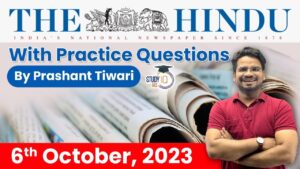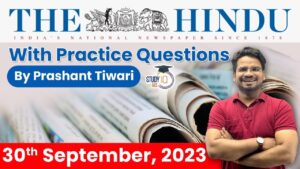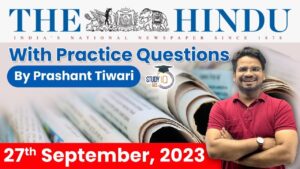The Hindu Newspaper Analysis for UPSC

The Hindu Newspaper Analysis 26 May 2023
- Do you consume “packaged or bottled water”? The Census wants to know. This will be one of the new questions in the next Census, which will also introduce “natural calamities” as a new option when asking about the factors responsible for migration of an individual or a family, besides existing options.
- Despite demands from several communities to be counted as a separate religion, the next Census will only count Hindu, Muslim, Christian, Buddhist, Sikh and Jain as options. Nature-worshipping Adivasis in Jharkhand, Chattisgarh and Odisha have been campaigning to include their Sarna faith as a separate religion, while Karnataka’s Lingayats have been making a similar demand.
- Though respondents can write the name of any other religion, no separate code will be provided.
The Hindu Editorial Today
Census:
- The census provides information on size, distribution and socio-economic, demographic and other characteristics of the country’s population.
- The Census was first started under British Viceroy Lord Mayo in 1872. It helped in framing new policies, government programs to uplift areas of improvement in the community.
- The first synchronous census in India was held in 1881. Since then, censuses have been undertaken uninterruptedly once every ten years.
Who conducts census?
- The responsibility of conducting the decennial Census rests with the Office of the Registrar General and Census Commissioner, India under the Ministry of Home Affairs, Government of India.
Historical Significance:
- ‘Rig-Veda‘ reveals that some kind of population count was maintained during 800-600 BC in India.
- Arthashastra by ‘Kautilya’ written in the 3rd Century BC prescribed the collection of population statistics as a measure of state policy for taxation.
- During the regime of the Mughal king Akbar, the administrative report ‘Ain-e-Akbari‘ included comprehensive data pertaining to population, industry, wealth and many other characteristics.

- About Sedition Law
- The sedition law, enshrined in Section 124A of IPC, was introduced by the British government in 1870 to tackle dissent against colonial rule.
- Section 124A states:
- “Whoever, words, either spoken or written, or by signs, or by visible representation, or otherwise, brings or attempts to bring into hatred or contempt, or excites or attempts to excite disaffection towards the Government established by law in India shall be punished with imprisonment for life, to which fine may be added, or with imprisonment which may extend to three years, to which fine may be added, or with fine.”
- The first known instance of the application of the law was the trial of newspaper editor Jogendra Chandra Bose in 1891.
- In 1922, Gandhi was arrested on charges of sedition in Bombay for taking part in protests against the colonial government and was sentenced to six years in prison. However, he was released after two years because of medical reasons.
- Tilak faced three trials in cases related to sedition and was imprisoned twice. In 1897, he was charged with sedition for writing an article in his weekly publication called Kesari and was sentenced to 12 months imprisonment.
- Mahatma Gandhi called Section 124A “the prince among the political sections of the IPC designed to suppress the liberty of the citizen”.
- Jawaharlal Nehru said that the provision was “obnoxious” and “highly objectionable”, and “the sooner we get rid of it the better”.
- In the landmark Kedar Nath versus Union of India case (1962), the SC upheld the constitutional validity of the sedition law while trying to curtail its misuse.
- The SC laid down that every citizen has a right to say or write about the government, by way of criticism or comment, as long as it does not “incite people to violence” against the government established by law or with the intention of creating public disorder.
- Reasonable Restrictions under Article 19: The State can impose restrictions on the freedom of speech and expression in the interests of
- Sovereignty And Integrity Of India,
- The Security Of The State,
- Friendly Relations With Foreign States,
- Public Order, Decency Or Morality, Or
- In Relation To Contempt Of Court,
- Defamation, Or
- Incitement To An Offence.

- The main Parliament House, inaugurated in 1927, consists of the circular-shaped structure which is visible from the outside.
- The Presiding Officers of the past have also emphasised the need to find a better solution. In 2012, the Speaker, Meira Kumar, stated that the Parliament building was “weeping,” and approved a high-powered committee to look for an alternative complex.
- The new building is more spacious, energy-efficient, and accessible.
- The inauguration of a new Parliament building presents an opportunity for us to seriously introspect on our parliamentary conduct to make Parliament more efficient and productive. The trend of increasing disruptions and long periods of deadlock is antithetical to the demand for politics to respond to the complex governance challenges of our time.
- About the Deputy Chairman of Rajya Sabha:
- It is a constitutional position created under Article 89 of the Constitution, which specifies that Rajya Sabha shall choose one of its MPs to be the Deputy Chairman as often as the position becomes vacant.
- Who can be a deputy chairman?
- The Deputy Chairman is elected by the Rajya Sabha itself from amongst its members.
- Whenever the office of the Deputy Chairman falls vacant, the Rajya Sabha elects another member to fill the vacancy.
- The Deputy Chairman vacates his office in any of the following three cases:
- if he ceases to be a member of the Rajya Sabha;
- if he resigns by writing to the Chairman;
- if he is removed by a resolution passed by a majority of all the members of the Rajya Sabha. Such a resolution can be moved only after giving 14 days’ advance notice.

- The Carbon Border Adjustment Mechanism (CBAM) is not intended to be “protectionist” and only meant to avoid the problem of ‘carbon leakage,’ said Frans Timmermans, European Union’s chief climate negotiator, on Friday.
- Indian industries will have nothing to worry if the carbon-intensity of goods, for eg. steel, aluminium and iron, made in India and exported to the EU matches that of the goods made in the bloc.
- ‘Carbon leakage,’ refers to cheaper, more carbon-intensive goods making their way into the EU at the expense of domestically manufactured products that have been manufactured using costlier, renewable energy. To check such leakage, the EU brought into force this month the CBAM that, after 2026, will require EU companies to annually declare the quantity of goods imported into the EU in the preceding year and their embedded greenhouse gas emissions and effectively pay for excessive emissions via CBAM certificates that could reflect as taxes paid by importers to the EU.
- Indian manufacturers have raised concerns that the tax will mean a 20-35% tariff on India’s exports of steel, aluminium and cement, that currently attract a duty of less than 3%. As much as 27% of India’s exports of steel, iron and aluminium products, or $8.2 billion, head to the EU.
- The CBAM will initially apply to imports of certain goods and selected precursors whose production is carbon-intensive and at most significant risk of carbon leakage: cement, iron and steel, aluminium, fertilizers, electricity and hydrogen.

- In an important step towards realising India’s ambitious Gaganyaan mission to put an Indian in space, the Indian Navy and the Indian Space Research Organisation (ISRO) released the Gaganyaan Recovery Training Plan at the Water Survival Training Facility (WSTF) at INS Garuda, Kochi.
- The human flight, after two unmanned flights, is scheduled to be launched in the fourth quarter of 2024.
Need of recovery:
- According to ISRO, as the safe recovery of the crew is the final step to be accomplished for any successful human spaceflight, it is of paramount importance and it has to be carried out with the minimum lapse of time.
- About:
- The Gaganyaan project envisages demonstration of human spaceflight capability by launching a crew of three members to an orbit of 400 km for a three day mission and bringing them back safely to earth, by landing in Indian sea waters.
- The first trial (uncrewed flight) for Gaganyaan is being planned by the end of 2023 or early 2024. This will be followed by sending Vyom Mitra, a humanoid and then with the crew onboard.
ISRO’s first human spaceflight mission:
- This manned mission will be the first of ISRO’s human spaceflight missions.
- The US, Russia and China are the only three countries to have conducted human spaceflights yet.
Launched by:
- ISRO’s Geosynchronous Satellite Launch Vehicle GSLV Mk III (3 stages heavy-lift vehicle).

- The Union Food Ministry on Friday countered the Opposition Congress’s allegation that the distribution of fortified rice through fair price shops is being done despite multiple warnings by experts and institutions such as NITI Aayog and the Food Safety and Standards Authority of India (FSSAI).
- The Ministry has been maintaining, citing various studies, that consumption of fortified rice resulted in significant improvement in haemoglobin levels and reduction in the prevalence of anaemia.
- The Ministry said rice fortification has been adopted by seven countries, including the U.S., since 1958.
- Fortification:
- Fortification is the addition of key vitamins and minerals such as iron, iodine, zinc, Vitamin A & D to staple foods such as rice, milk and salt to improve their nutritional content.
- These nutrients may or may not have been originally present in the food before processing.
- Fortification of Rice:
- According to the Food Ministry, fortification of rice is a cost-effective and complementary strategy to increase vitamin and mineral content in diets.
- According to FSSAI norms, 1 kg fortified rice will contain iron (28 mg-42.5 mg), folic acid (75-125 microgram) and Vitamin B-12 (0.75-1.25 microgram).
- In addition, rice may also be fortified with micronutrients, singly or in combination, with zinc, Vitamin A, Vitamin B1, Vitamin B2, Vitamin B3 and Vitamin B6.


 The Hindu Newspaper Analysis 6 October 2...
The Hindu Newspaper Analysis 6 October 2...
 The Hindu Newspaper Analysis 30 Septembe...
The Hindu Newspaper Analysis 30 Septembe...
 The Hindu Newspaper Analysis 27 Septembe...
The Hindu Newspaper Analysis 27 Septembe...





















